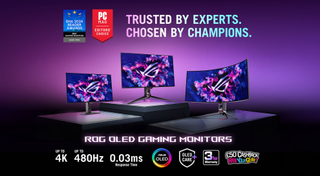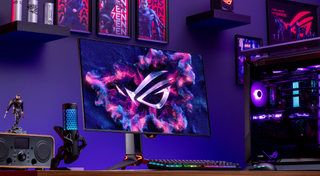Ever since they raised their flag to found the Republic of Gamers (ROG) back in 2006, Asus has been one of the trailblazers of gaming hardware. Among their many 'World Firsts', Asus released the world's first 144Hz gaming monitor back in 2012, the world's first G-Sync monitor in 2014, and world's first mini-LED display in 2021; this gaming powerhouse has long spearheaded technological progress in the industry, and it's showing no signs of slowdown.
Now, Asus ROG's OLED gaming monitor range is here to set new standards in the space, so we're going to talk about what truly makes a great OLED panel. Beyond the deep blacks and impossibly high refresh rates, you also need to consider resolutions, response times, refresh rates, and myriad other features, so join us as we team up with ASUS ROG to help you find a ROG monitor that will last you deep into the future—whether you're in search of searing frame-rates in first-person shooters or a sprawling screen space for multitasking.

If you currently own a IPS or TFT monitor, you're probably curious about what an OLED panel offers that your current one doesn't. Unlike IPS, OLED monitors don't require a backlight, so are markedly slimmer. Due to the fact that each pixel in an OLED panel is lit, backlight bleeding is a thing of the past, while black pixels don't even switch on, saving energy at the same time as creating 'true' blacks for much richer, deeper contrast. Motion clarity on an OLED panel is significantly higher too, with near-indiscernible ghosting and blur (something you'll really come to appreciate in racing sims and other fast-moving 3D games). In fact, motion clarity on a 240Hz OLED panel is about equivalent to a 360Hz IPS one.
Within the ROG OLED monitor range, you can choose from QD-OLED and WOLED displays. Both offer the same perfect blacks and deep contrast, but for the ultimate brightness and colour accuracy, you'll want to go for a QD-OLED, such as the ROG Swift PG32UCDM, which combines traditional OLED tech with quantum dots to deliver unrivalled image quality—perfect for gamers as well as creators needing the best colour accuracy possible.
The upside of WOLED monitors is that they are more affordable and energy-efficient, while still offering great contrast ratios. So on that front check out the ROG Swift PG27AQDP, which also happens to be the world's first monitor to sport a 480 Hz refresh rate. This translates to mercury-smooth motion and virtual elimination of screen-tearing, especially when combined with G-SYNC and FreeSync (all ROG OLED monitors have FreeSync and are G-SYNC-compatible). While we're on the topic of refresh rates, the lowest you're going to get with a ROG monitor is 240 Hz, so you can rest assured that it will do justice to whatever GPU you throw at it.

Asus ROG uses high-quality LG panels for its glossy and semi-glossy monitors, but if glare and reflections are a concern, then they have you covered with custom-designed semi-matte anti-glare finishes. These surfaces span the size range of ROG OLED monitors, which go from 27" options such as the ROG Swift PG27AQDM all the way up to the 49" behemoth that is the ultrawide ROG Swift PG49WCD—a monitor wide enough to give you a vast, unbounded workspace by day, and unparalleled gaming immersion by night. It's a monitor fit for a full-on sim rig, whether you want to keep your eyes on drivers attempting to overtake you in Forza Horizon 5, or surround yourself in the vast cosmos of Elite Dangerous.
Every ASUS ROG monitor is supported by an arsenal of powerful onboard technologies that supercharge the screen experience even further. Dual Mode, currently available on the ROG Swift PG32UCDP, lets you switch seamlessly between high refresh rates and high resolutions, depending on the kind of gaming you're doing. If you want that super-sharp image clarity to fully take in the landscapes of the old west in Red Dead Redemption 2 or the mystical Norse realms of God of War Ragnarok, then set Dual Mode to 4K/240Hz. For blisteringly paced online games like Call of Duty or Apex Legends where frames take priority over pixels, then go for FHD/480Hz.

ROG-Exclusive Anti-Flicker Technology reduces flicker when your monitor changes refresh rates in G-Sync or FreeSync, reducing eye strain so that you can keep going into the small hours. Then there's the OLED Care Suite, which utilises pixel-shifting, logo dimming, and other screen-wiping tools to extend your panel's longevity well into the future (with a three-year warranty on most OLED models to boot).
With all that firepower on offer at ASUS ROG, the only thing that's going to hold you back from peak gaming performance is your GPU. Unless you're content in admiring the smooth movement of your mouse cursor around your screen, there's no point having a monitor in the 240HZ-480Hz range if you don't have a GPU powerful enough to hit those heights. For 4K and ultrawide gaming, you should probably look for something like an ASUS Dual Nvidia RTX 4070 or an ASUS TUF Gaming RX 7800 XT, utilising AI upscaling technologies such as Nvidia DLSS and AMD FSR, along with Frame Generation (RTX 40-series only) or AMD Fluid Motion Frames, to hit those high refresh rates. These cards also feature HDMI 2.1 and DisplayPort 1.4/2.0 ports, which is a must to carry the kinds of resolutions and refresh rates ASUS ROG's monitor range is capable of.
So head over to the ASUS games hardware store or Amazon and get yourself kitted out. There's currently a 'Rate your Gear' promotion too, where you can get up to £50 cashback on select OLED monitors when you buy one and leave a review, but you'll need to be quick because this is only available until December 31, 2024.
To keep up with all the latest inventions at the ASUS lab, you can follow them on Facebook and Instagram.

 3 weeks ago
9
3 weeks ago
9









 English (US) ·
English (US) ·